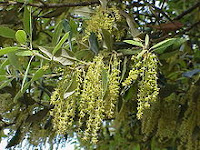YELLOW-BERRIED NIGHTSHADE, SOLANUM SURRATENSE, KAANDERI IN URDU
Yellow-berried or Spiny nightshade is a native of the Indian subcontinent, parts of North Africa, tropical Australia, Polynesia and South-East Asia. As its names suggest it has yellow berries and spiny stems and hairy leaves. It grows prostrate along the ground and has either white or blue-purple flowers. It has been employed in traditional medicine for centuries and is used for a number of ailments. Its other Latin name was Solanum xanthocarpum, but it is now known as S. surratense, with there being a new variant discovered in Pakistan
 It is a member of the Belladonna, or nightshade family so is related to the Nipple fruit, aubergine, tomato, potato, Cape gooseberry, tomatillo and the Chinese lantern, to name but a few in this family. It is highly valued in folk and Ayurvedic medicine and used in combination with other herbs and alone to cure various ailments. For example, a decoction of the root is combined with asafoetida (heng) and rock salt for spasmodic coughs, and the same decoction can be combined with long pepper (Piperi longum) and honey for coughs and asthma. The leaf juice with black pepper is used for rheumatism, and this is used with other herbs in cases of dengue fever, acute bronchitis and fevers which are accompanied by chest infections.
It is a member of the Belladonna, or nightshade family so is related to the Nipple fruit, aubergine, tomato, potato, Cape gooseberry, tomatillo and the Chinese lantern, to name but a few in this family. It is highly valued in folk and Ayurvedic medicine and used in combination with other herbs and alone to cure various ailments. For example, a decoction of the root is combined with asafoetida (heng) and rock salt for spasmodic coughs, and the same decoction can be combined with long pepper (Piperi longum) and honey for coughs and asthma. The leaf juice with black pepper is used for rheumatism, and this is used with other herbs in cases of dengue fever, acute bronchitis and fevers which are accompanied by chest infections. A paste made from the root is applied to hernias by tribal people in
A paste made from the root is applied to hernias by tribal people in The stem, fruit and flowers are used in medicine as well as the root, although the upper parts of the plant are usually dried and administered in powder form. The seeds and roots make good expectorants for coughs and bronchial problems. The bruised leaves can be applied to feet if there is a burning sensation in them and for this people also used water in which turnips have been boiled as well as a paste of henna being plastered on the soles of the feet. The juice from the berry is supposed to be good for sore throats. The whole plant is said to have diuretic properties and is used for the manufacture of cortisone.
Research has shown that extracts of the plant have antifungal, antibacterial, antioxidant and antiviral properties, and in rats an extract has been shown to combat ulcers. It may also help to lower blood pressure and inhibit some forms of cancer, although much more research is needed before this can be established. The plant does contain the bioflavonoid, quercetin which seems to have anticancer properties, and is also found in the outermost layers of onions, red grapes, parsley and apples. It contains diosgenin, and apeginin, as well as caffeic acid, various tannins, alkaloids, other flavonoids, glycosides and phenolic compounds.
 More research is still to be done on this plant but meanwhile it will still be used in traditional medicine in the Indian subcontinent.
More research is still to be done on this plant but meanwhile it will still be used in traditional medicine in the Indian subcontinent.

















